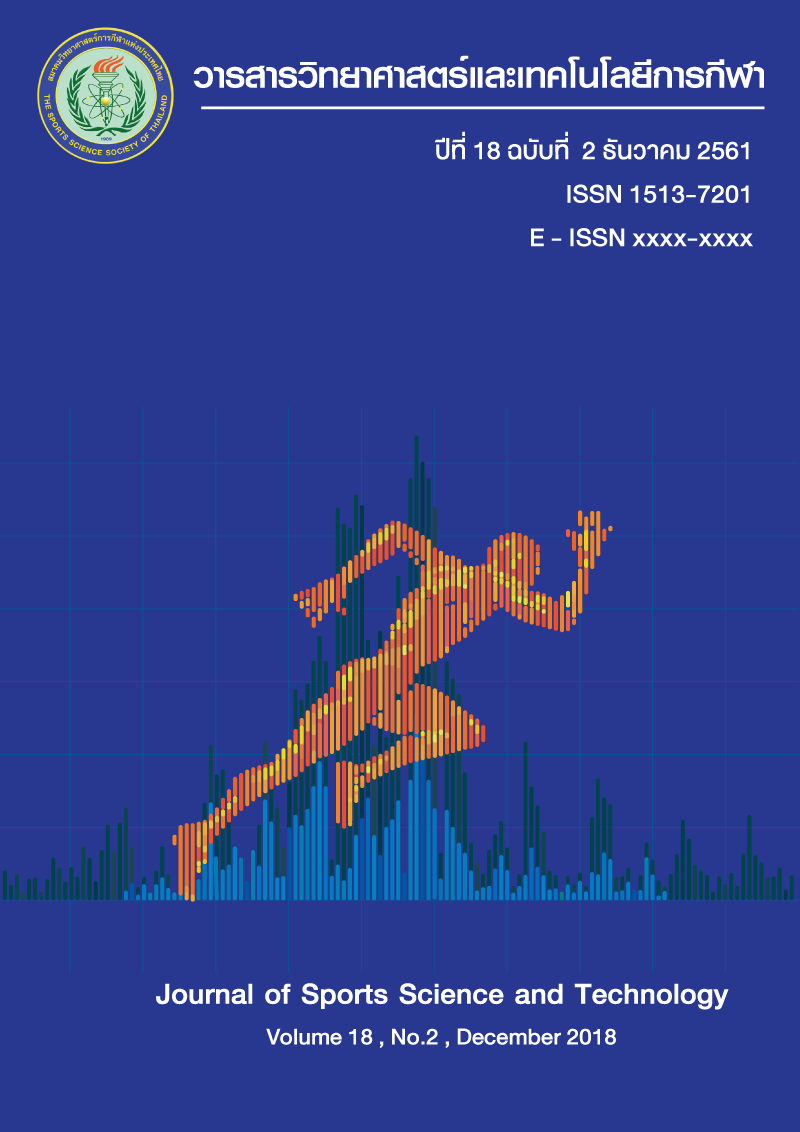EFFECT OF UPPER LIMB ON GROUND REACTION FORCES DURING SINGLE-LEG JUMP STOP LANDING TASK
Keywords:
Basketball, Dominant/non-dominant leg, Ground reaction force, Landing.Abstract
Blocking shot is one of the defensive basketball skills where a player raises an arm to block or intercept a shot. To block a shot, a player usually jumps and lands on one leg. Previous study investigated ground reaction forces (GRF) during drop vertical jump. However, there is no previous study that has investigated the effect of single arm motion on GRFs during single-leg landing (SLL). Therefore, the purpose of the study was to investigate and compare the effect of dominant and non-dominant arm raise on GRFs during SLL. Five female basketball players (x̄ age = 20.40 ± 0.44 years old, x̄ weight= 64.80 ± 7.71 kg and x̄ height= 1.71 ± 0.03 m) participated in this study. Participants performed single-leg landing (SLL) onto a force platform on 4 conditions; 1) non-dominant arm raise landing by non-dominant leg (NDA-NDL), 2) non-dominant arm raise landing by dominant leg (NDA-DL) 3) dominant-arm raise landing by dominant-leg (DA-DL) and 4) dominant-arm raise landing by non-dominant leg (DA-NDL). The vertical GRF at maximum results showed significant differences between NDA-NDL vs. DA-DL and NDA-NDL vs, DA-NDL. Whilst, the peak posterior GRF results show no significant difference between 4 conditions. This study shows that non-dominant arm raise has an effect on ground reaction forces. Therefore, researchers suggest that basketball players should practice to improve the use of a non-dominant arm when landing after performing blocking shot for alternatively defense action.
(Journal of Sports Science and Technology 2018; 18(2): 120-127)
Key Words: Basketball, Dominant/non-dominant leg, Ground reaction force, Landing.
*Corresponding author: Weerawat LIMROONGREUNGRAT College of Sports Science and Technology Mahidol University, Nakhon Pathom, Thailand 73170 E-mail: [email protected]
References
2. Cowley HR, Ford KR, Myer GD, Kernozek TW, Hewett TE. Differences in neuromuscular strategies between landing and cutting tasks in female basketball and soccer athletes. J Athl Training. 2006;41(1):67.
3. Masters C, Johnstone J, Hughes G. The effect of arm position on lower extremity kinematics during a single limb drop landing: a preliminary study. Journal of Functional Morphology and Kinesiology. 2016;1(3):282-8.
4. Chaudhari AM, Hearn BK, Andriacchi TP. Sport-dependent variations in arm position during single-limb landing influence knee loading: implications for anterior cruciate ligament injury. The American journal of sports medicine. 2005;33(6):824-30.
5. Kaplan DÖ. Evaluating the Relation between Dominant and Non-Dominant Hand Perimeters and Handgrip Strength of Basketball, Volleyball, Badminton and Handball Athletes. International Journal of Environmental and Science Education. 2016;11(10):3297-309.
6. Orishimo KF, Kremenic IJ, Mullaney MJ, McHugh MP, Nicholas SJ. Adaptations in single-leg hop biomechanics following anterior cruciate ligament reconstruction. Knee Surg, Sports Traumatol, Arthrosc. 2010;18(11):1587-93.
7. Augustsson J, Thomee R, Linden C, Folkesson M, Tranberg R, Karlsson J. Single‐leg hop testing following fatiguing exercise: reliability and biomechanical analysis. Scand J Med Sci Sports. 2006;16(2):111-20.
8. Nin DZ, Lam WK, Kong PW. Effect of body mass and midsole hardness on kinetic and perceptual variables during basketball landing manoeuvres. J Sports Sci. 2016;34(8):756-65.
9. Rosen AB, Ko J, Brown CN. Single-limb landing biomechanics are altered and patellar tendinopathy related pain is reduced with acute infrapatellar strap application. The Knee. 2017;24(4):761-7.
10. Kerdsomnuk P, Limroongreungrat W, Chaunchaiyakul R. Technology. Ground reaction force and loading rate during sepaktakraw spike landings. J Sports Sci Tech. 2015;15(1):1-8.
11. Cowling E, Steele J. The effect of upper-limb motion on lower-limb muscle synchrony: implications for anterior cruciate ligament injury. J Bone Jt Surg. 2001;83(1):35-41.
12. Kabacinski J, Murawa M, Dworak LB, Maczynski J. Differences in ground reaction forces during landing between volleyball spikes. Trends Sport Sci. 2017;24(2).
13. Dai B, Garrett WE, Gross MT, Padua DA, Queen RM, Yu B. The effects of 2 landing techniques on knee kinematics, kinetics, and performance during stop-jump and side-cutting tasks. Am J Sports Med. 2015;43(2):466-74. 14. Niu W, Wang Y, He Y, Fan Y, Zhao Q. Kinematics, kinetics, and electromyogram of ankle during drop landing: a comparison between dominant and non-dominant limb. Human Movement Sci. 2011;30(3):614-23.






